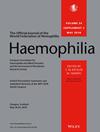Multimodal Exercise Program of Balance and Strength Improves Dynamic Balance, Strength and Functionality and Decreases the Risk of Falls in Adults With Haemophilia
Abstract
Introduction
Haemophilia is a hereditary bleeding disorder that leads to joint damage and musculoskeletal impairments, affects balance and increases the risk of falls. Although exercise is beneficial, little is known about the clinical effects of programmes that focus on balance and proprioception in people with haemophilia (PwH). The aim of this study is to evaluate the effectiveness of a 12-week multimodal balance and strength training programme (MBSTP) on balance, fall risk, strength, functionality, kinesiophobia and quality of life (QoL) in adult PwH.
Methods
A single-blind non-randomized controlled trial was conducted with 22 PwH (mean age 34.5 ± 9.2 years). Participants were assigned to an experimental group (EG, n = 11), who underwent the MBSTP, or a control group (CG, n = 11), who continued their usual exercises. Static and dynamic, fall risk, strength and functionality (Time Up and Go, Sit to Stand Test and 2-Minute Walk Test), kinesiophobia and QoL were assessed pre- and post-intervention, Additionally, the participants’ satisfaction with the programme was measured. Intervention effects were determined with a two-way mixed ANOVA.
Results
The EG presented significant improvements (p < 0.05, with a small to large effect size) in balance (bipodal open eyes in unstable surface and monopodal total-velocity, LoS and subjective perception of balance), functionality, fall risk and strength (quadriceps and gluteus medius) compared to the CG. The EG reported high satisfaction with the programme.
Conclusion
Given the significant improvements in dynamic balance, lower limb strength, functionality and fall risk reduction, integrating supervised multimodal exercise programmes into routine rehabilitation for PwH could enhance mobility and prevent falls.
Trial registration
ClinicalTrials.gov identifier: NCT04122014.


 求助内容:
求助内容: 应助结果提醒方式:
应助结果提醒方式:


